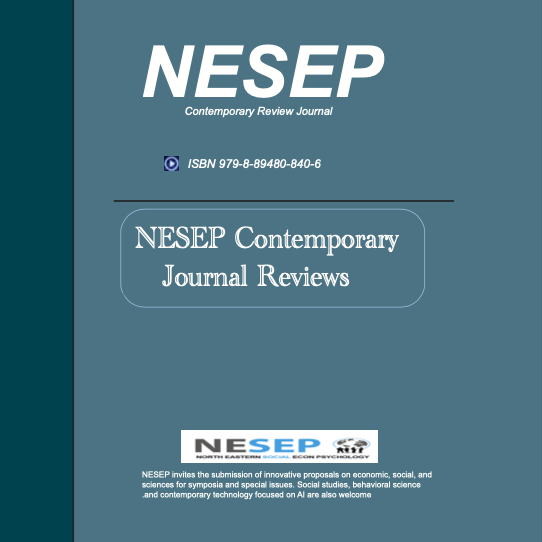Featured Issues
Below are compilations of selected work related to a contemporary matter area.

Palma, Spain. 6/30~7/2, 2025.
ISBN 2: 979-8-89480-848-2
Annual Conference
Publisher: NESEP
The Accelerated Retreat of Andean Glaciers: Using Google Earth Engine and Landsat Satellite Imagery to Quantify the Imminent Threat to Water Security in Andean Communities
Abstract:
In this experiment working with Chromium and Eisenia fetida studying the health and behaviors of Eisenia fetida and how Chromium will affect their behaviors when exposed to Chromium. Other researchers that have done similar research showed that their Eisenia fetida have died because of being exposed to too much Chromium or in other experiments they did not have an outcome because the Eisenia fetida was not exposed to enough Chromium. The Eisenia fetida will be exposed to Chromium for about 2 weeks. The worms will be monitored. The habitat of the Eisenia fetida is moist soil, although some Eisenia fetida actually prefer mud, such as the mud that is found along the shores of lakes or swamps. Eisenia fetida can be found in the soil of backyards as well as near bodies of fresh and saltwater. When the Eisenia Fetida arrive there will be an enclosure for them to be in. Earthworms eat soil. Their nutrition comes from things in soil, such as decaying roots and leaves. The entire surface of a worm's body absorbs oxygen and releases carbon dioxide. Moisture Eisenia Fetida moves by squeezing muscles around their water- filled bodies. The Earthworms will lose weight when being exposed to Chromium. They will also shrink and the regeneration process for the earthworms will slow down. This shows how Chromium does have an effect on Eisenia fetida and can cause the worms to have different effects.
Keywords: Eisenia fetida, Earthworms, Sublethal doses, Hexavalent chromium
References
-
Anderson, B., Mackintosh, A., Stumm, D., George, L. A., Kerr, T., Winter-Billington, A., & Fitzsimons, S.
J. (2010). Climate sensitivity of a high-precipitation glacier in New Zealand. Journal of Glaciology,
56(195), 114–128. https://doi.org/10.3189/002214310791190929 -
Carrivick, J.L., Tweed, F.S. (2016). A global assessment of the societal impacts of glacier outburst floods.
Global and Planetary Change, 144, 1–16.
Cereceda-Balic, F., Ruggeri, M. F., Vidal, V., Ruiz, L., & Fu, J. S. (2022). Understanding the role of
anthropogenic emissions in glaciers retreat in the central Andes of Chile. Environmental Research, 214,
113756. https://doi.org/10.1016/j.envres.2022.113756 -
Cordero, R. R., Asencio, V., Féron, S., Damiani, A., Llanillo, P. J., Sepulveda, E., Jorquera, J., Carrasco, J.,
& Casassa, G. (2019). Dry-Season Snow Cover Losses in the Andes (18°–40°S) driven by Changes in
Large-Scale Climate Modes. Scientific Reports, 9(1). https://doi.org/10.1038/s41598-019-53486-7 -
Ding, Y., Liu, S., Li, J., & Shangguan, D. (2006). The retreat of glaciers in response to recent climate
warming in western China. Annals of Glaciology, 43, 97–105.
https://doi.org/10.3189/172756406781812005 -
Dussaillant, I., Berthier, E., Brun, F., Masiokas, M., Hugonnet, R., Favier, V., Rabatel, A., Pitte, P., &
Ruiz, L. (2019). Two decades of glacier mass loss along the Andes. Nature Geoscience, 12(10), 802–808.
https://doi.org/10.1038/s41561-019-0432-5 -
Eghdami, M., & Barros, A. P. (2019). Extreme orographic rainfall in the eastern Andes tied to cold air
intrusions. Frontiers in Environmental Science, 7. https://doi.org/10.3389/fenvs.2019.00101 -
Emmer, A. (2018). GLOFs in the WOS: Bibliometrics, geographies and global trends of research on glacial
lake outburst floods (Web of Science, 1979-2016). Natural Hazards and Earth System Sciences, 18(3),
813–827. -
Farias-Barahana, D., Vivero, S., Casassa, G., Schaeferm, M., Burgerm, F., Seehaus, T., Anacona, P.I.,
Escobar, F., Braun, M.H., 2019. Geodetic mass balances and area changes of Echaurren Norte Glacier
(central Andes, Chile) between 1955 and 2015. Rem. Sens. 11 (3), 260.
https://doi.org/10.3390/rs11030260. -
Gardner, A. S. et al. (2013). A reconciled estimate of glacier contributions to sea level rise: 2003 to 2009.
Science, 340, 852–857.
Garreaud, R. D., Vuille, M., Compagnucci, R. & Marengo, J. Present-day South American climate.
Palaeogeogr. Palaeoclimatol. Palaeoecol. 281, 180–195 (2009). -
Green, J. K., Konings, A. G., Alemohammad, S. H., Berry, J. A., Entekhabi, D., Kolassa, J., Lee, J., &
Gentine, P. (2017). Regionally strong feedbacks between the atmosphere and terrestrial biosphere. Nature
Geoscience, 10(6), 410–414. https://doi.org/10.1038/ngeo2957 -
Hanshaw, M.N., Bookhagen, B., 2014. Glacial areas, lake areas, and snow lines from 1975 to 2012: status
of the Cordillera Vilcanota, including the Quelccaya Ice Cap, northern Central Andes, Peru. Cryosphere 8,
359–376. -
Harrison, S., Kargel, J.S., Huggel, C., Reynolds, J., Shugar, D.H., Betts, R.A., Emmer, A., Glasser, N.,
Haritashya, U.K., Klimeˇs, J., Reinhardt, L. (2018). Climate change and the global pattern of moraine-
dammed glacial lake outburst floods. Cryosphere, 12(4), 1195–1209. -
Veettil, B., de Souza, S.F., 2017. Study of 40-year glacier retreat in the northern region of the Cordillera
Vilcanota, Peru, using satellite images: preliminary results. Rem. Sens. Lett. 8 (1), 78–85. -
Vuille, M., Carey, M., Huggel, C., Buytaert, W., Rabatel, A., Jacobsen, D., Soruco, Á., Villacís, M.,
Yarlequé, C., Timm, O. E., Condom, T., Salzmann, N., & Sicart, J. (2018). Rapid decline of snow and ice
in the tropical Andes – Impacts, uncertainties and challenges ahead. Earth-Science Reviews, 176, 195–213. -
Wood, J. N., Harrison, S. P., Wilson, R. J., Emmer, A., Yarleque, C., Glasser, N. F., Torres, J. P.,
Caballero, A. C., Araújo, J. P., Bennett, G. L., Diaz-Moreno, A., Garay, D., Jara, H., C. (2021).
Contemporary glacial lakes in the Peruvian Andes. Global and Planetary Change, 204, 103574.
https://doi.org/10.1016/j.gloplacha.2021.103574.